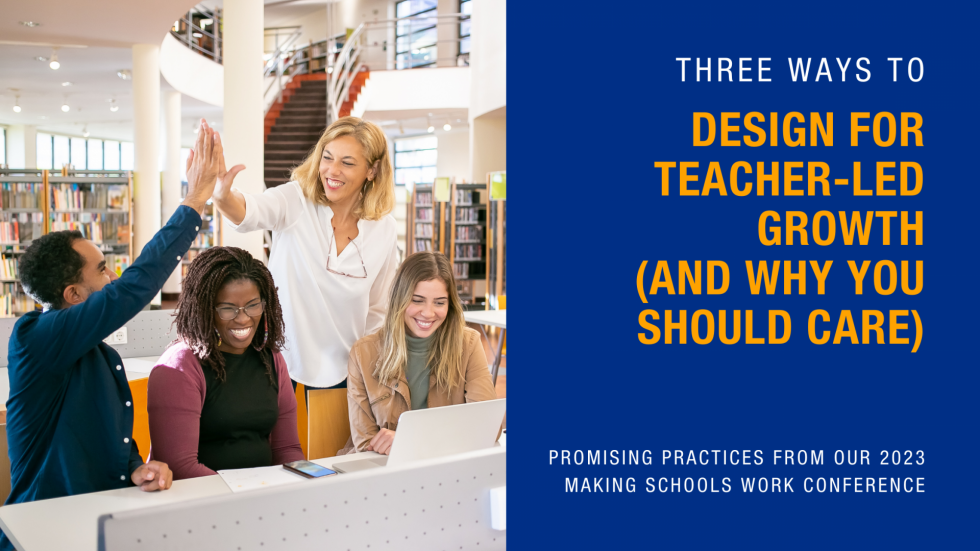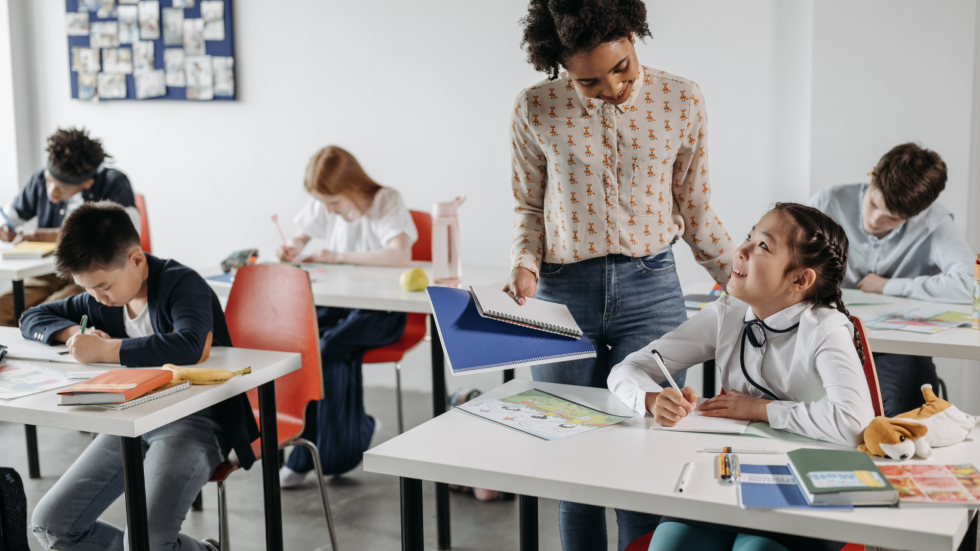Three Ways to Design for Teacher-Led Growth (and Why You Should Care)
Prefer to listen? Check out the audio recording of this post instead.
Teaching is a world of juxtapositions — it’s both draining and energizing, regimented and creative, a solo endeavor and a team effort. A teacher is simultaneously in charge of everything and nothing on any given day.
Whether it’s in a large or small school district, teachers report feeling isolated and overwhelmed with the unique demands of their positions. The way our schools are currently set up does not often allow teachers to have the time and the space during a regular workday to re-energize themselves by collaborating with their colleagues or seeking growth opportunities.
When talking to school leaders about teacher collaboration and growth, leaders often talk about the ways that they are helping — class visits with feedback, carving out time for PLCs and offering professional development opportunities. These are all important, but is this truly getting to the essence of building teacher self-efficacy and sparking teacher passion for their work? Are we really getting at the heart of inspirational teacher collaboration?
Why We Need Something More
Let’s start with the topic of getting into classrooms. Leaders often set up learning walks, instructional rounds and classroom visits; sometimes even including other teachers. The intent of these class visits is to help teachers grow and collaborate, but even with positive feedback (grow and glows, wows and wonders) they are evaluative by nature.
Then, of course, there are professional learning communities, or PLCs. PLCs are meant to give a dedicated time for teachers to talk to each other about student learning, data, teaching strategies and lesson planning. However, the feedback about most PLCs is that they are missing the mark.
Teachers report feeling frustrated by the requirements, with others telling them what to talk about in their PLCs, and never getting to what they need or want to discuss. PLCs become a time where instructional coaches talk about data, do professional development and talk about district or school initiatives. While all of this may be important, how can we use some of this time differently?
Why Empowering Teachers to Lead Their Learning Helps Everyone
In schools where we have seen evidence of individual and collective teacher growth, it has been in places where teachers are empowered to lead their own learning.
But perhaps you say, “Wait a minute! How can I trust teachers to know what they need and to lead their own learning?”
Well, we’ve been asking teachers to do this with their own students for years. We’ve been asking them to create classrooms that foster student ownership and student-led learning. This is no different. Now, leaders have the responsibility to do the same for the teachers they lead. The same language for student ownership applies to teacher ownership. Teacher voice and choice is just as vital to the culture of learning as student voice and choice.
In a classroom of students, a teacher can’t just walk in and say, “Okay, students, you are now in charge of your own learning. What do you want to learn and what do you want to do?” It has to be scaffolded in the classroom, just as it has to be scaffolded with teachers.
The primary concept to keep in mind is whoever is doing the work is doing the learning. We know this to be true with students and it is equally true with adults.
Why You Should Start Small
As with any initiative, doing too much too fast increases the odds of total catastrophe. Schools who have had success have started with a small cohort of teachers who are passionate about student learning and are willing to try something new.
Let these small cohorts explore, help create the framework and work out the obstacles in the process. Consider what can be taken off the teachers’ plates while they engage. Start with a protocol such as “Looking at Student Work.”
In fact, the School Reform Initiative is just a great resource to know about in general!
Three Ways to Begin Putting Teachers in Charge of Their Own Growth
Method 1: Let Them Use Student Work
Let’s go directly to the heart of the matter and have teachers bring in student work to look at with their peers.
In looking at student work, ask a volunteer teacher to bring a class set of student work from a recent assignment to a PLC session. To really make this work, the teacher should invite teachers from other grade levels and/or content areas. This may mean changing up how some PLCs are organized.
Why is this such an important aspect of this protocol? Teachers are well-versed in meeting with teachers from their same content and same students. This can, after a while, create group-think or an echo chamber of ideas. If we are looking at work in an area we teach, we fill in the blanks in our head and make assumptions about what the teacher taught and what the students know. When teachers look at an unfamiliar set of work, they become truly inquisitive about the lessons and the artifacts and are much more likely to generate questions and ideas that push the teacher’s thinking.
By the end of this process, teachers begin to see how they might restructure their class lessons to get a different/better outcome in their students’ work. This process naturally evolves into a second step: looking at the lesson planning.
Method Two: Have Them Look at Lessons
When we say “looking at lesson planning,” we are not just talking about the 10-page lesson planning document that the teacher might be required to create or just blanks in a template waiting to be filled in. We are talking about keeping student learning and outcomes at the heart of the matter. What do they want students to learn and how will they know it is happening? What actually has to happen in the class for students to show evidence that they are learning at a higher level? Again, in this process, it is helpful to be surrounded by people in those different content areas and/or grade levels.
Method Three: Let Teachers Open Their Classrooms to Peers
The third step in this process, asks teachers to open their classrooms to their peers on their invitation, not as an administrative planned visit. The teacher has looked at student work, helped create a new lesson, and now, perhaps even those same peers, can come into the classroom to see how students are engaging. However, this is not a class visit where someone walks in with a checklist and evaluates the teacher. In this scenario, the teacher invites peers to come in at a specific time at a specific date to collect a specific set of data that will be meaningful to the teacher. The teacher decides what the peers/visitors will look for and record.
The entire focus of the visit is around what the students are learning and a specific student learning question. There are many iterations of peer visits and teacher-led instructional rounds. We encourage schools to keep it simple and let teachers decide how to design their visits. Contact us for more information and lessons learned about implementation.
Final Thoughts
Yes, in the beginning, these processes may seem cumbersome and time consuming. We recommend following these processes until teachers gain a comfort level with how they work. This certainly isn’t something you could do every day or even every week.
The importance is that it creates a paradigm shift in how teachers view their practice and collaborate with their peers. These processes get to the heart of what matters in a school: student learning and a collective teacher point of view on how to improve student outcomes.
There are no shortcuts. There are no magic programs that can replicate this process.
When given these tools and processes, and the time and safety to implement them with fidelity, we believe that teachers have the knowledge and power to have strong impact on the culture of learning in their own classrooms and the whole school.
There is nothing more powerful than educators sharing their ideas and asking each other authentic questions about student learning.
Look for our session on this topic at the SREB Making Schools Work Conference in July 2024!
And sign up for the Promising Practices Newsletter to get more helpful articles like this one.






